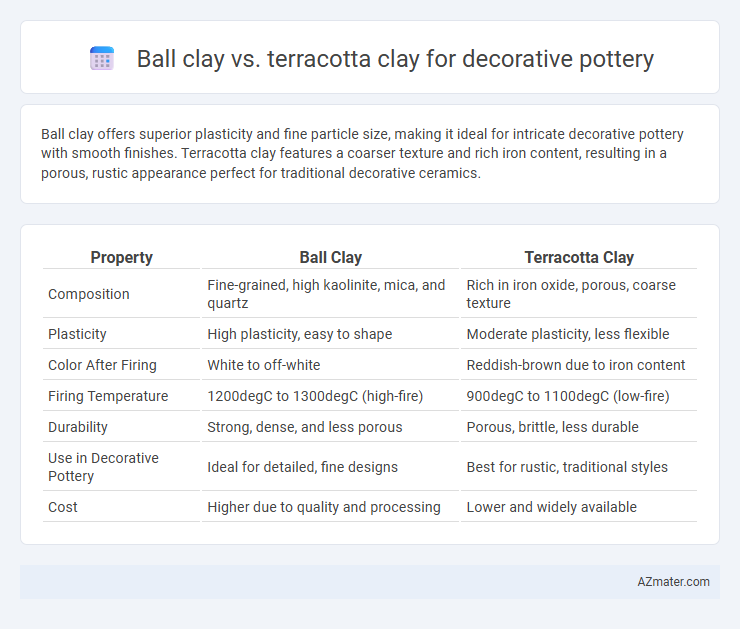Ball clay offers superior plasticity and fine particle size, making it ideal for intricate decorative pottery with smooth finishes. Terracotta clay features a coarser texture and rich iron content, resulting in a porous, rustic appearance perfect for traditional decorative ceramics.
Table of Comparison
| Property | Ball Clay | Terracotta Clay |
|---|---|---|
| Composition | Fine-grained, high kaolinite, mica, and quartz | Rich in iron oxide, porous, coarse texture |
| Plasticity | High plasticity, easy to shape | Moderate plasticity, less flexible |
| Color After Firing | White to off-white | Reddish-brown due to iron content |
| Firing Temperature | 1200degC to 1300degC (high-fire) | 900degC to 1100degC (low-fire) |
| Durability | Strong, dense, and less porous | Porous, brittle, less durable |
| Use in Decorative Pottery | Ideal for detailed, fine designs | Best for rustic, traditional styles |
| Cost | Higher due to quality and processing | Lower and widely available |
Introduction to Ball Clay and Terracotta Clay
Ball clay is a highly plastic, fine-grained sedimentary clay composed mainly of kaolinite, known for its exceptional strength and white firing properties, making it ideal for intricate decorative pottery. Terracotta clay contains higher levels of iron oxide, which imparts a characteristic reddish-brown color and is less plastic but more porous, often used for rustic and earthy pottery designs. Both clays serve unique aesthetic and functional purposes, with ball clay offering smooth finishes and terracotta providing signature warmth and texture in decorative ceramics.
Composition and Mineral Content Comparison
Ball clay is composed primarily of kaolinite, mica, and quartz, offering high plasticity and fine particle size ideal for detailed decorative pottery. Terracotta clay contains a higher proportion of iron oxide, giving it a characteristic reddish-brown color and moderate plasticity suitable for rustic and textured pottery finishes. The mineral content differences result in ball clay yielding a smoother, more refined surface, while terracotta provides durability and distinctive earthy aesthetics.
Physical Properties and Texture Differences
Ball clay features a fine, smooth texture with high plasticity, making it ideal for intricate decorative pottery requiring detailed shaping and refinement. Terracotta clay, characterized by its coarse, porous texture and moderate plasticity, provides a rustic appearance and is more suitable for larger, less detailed decorative pieces. The physical properties of ball clay allow for tighter compaction and a smoother finish, whereas terracotta's porosity offers better breathability but a rougher surface texture.
Color Variations and Firing Outcomes
Ball clay offers a smooth texture and plasticity ideal for detailed decorative pottery, producing off-white to light beige colors with a smooth, often glossy finish after firing. Terracotta clay, rich in iron oxide, results in warm reddish-orange hues and a porous, rustic surface that enhances earthy, traditional pottery aesthetics. Firing temperatures vary significantly; ball clay matures at higher cone ranges (around cone 5-10), yielding durable stoneware, while terracotta is fired at lower temperatures (cone 04-06) producing earthenware with distinct color variations influenced by atmospheric firing conditions.
Workability for Decorative Pottery
Ball clay offers exceptional workability for decorative pottery due to its fine particle size and high plasticity, making it ideal for intricate detailing and smooth finishes. Terracotta clay, while less plastic, provides a coarser texture that is better suited for rustic, earthy designs but can be more challenging to manipulate for delicate shapes. The higher plasticity of ball clay results in fewer cracks during drying, ensuring greater precision and durability in decorative pieces.
Firing Temperature and Techniques
Ball clay, known for its plasticity and high-firing range of 1200degC to 1300degC, is ideal for producing durable, fine-grained decorative pottery through techniques like slip casting and wheel throwing. Terracotta clay, typically fired at a lower temperature between 900degC and 1100degC, offers a porous, rustic finish suited for hand-building and surface texturing methods. Choosing between these clays depends on desired finish, firing temperature constraints, and the decorative techniques employed.
Durability and Finished Strength
Ball clay offers higher plasticity and superior strength when fired, resulting in durable, finely detailed decorative pottery with minimal shrinkage and cracking. Terracotta clay, characterized by its porous nature and lower fired strength, tends to be less durable and more prone to chipping or breakage in finished pieces. For long-lasting decorative pottery requiring robust finished strength, ball clay is the preferred choice due to its enhanced mechanical properties and firing consistency.
Glazing Suitability and Effects
Ball clay offers excellent plasticity and is ideal for decorative pottery requiring a smooth, fine texture that accepts glazing uniformly, resulting in a glossy and vibrant finish. Terracotta clay, with its porous and coarse nature, typically produces earthy, matte surfaces but can achieve rustic glaze effects that emphasize texture and natural tones. For glazing, ball clay enhances color brightness and glaze adherence, while terracotta provides a warm, organic look with less glaze smoothness, suitable for traditional or rustic pottery styles.
Typical Uses in Decorative Pottery
Ball clay is favored in decorative pottery for its plasticity and smooth texture, making it ideal for detailed molds and intricate designs. Terracotta clay, known for its porous nature and warm reddish-brown color, is typically used for rustic, earthy decorative pieces such as planters and tiles. Both clays are valued for their unique finishes, with ball clay providing fine detail and terracotta offering a traditional, natural aesthetic.
Choosing the Right Clay for Your Project
Ball clay offers excellent plasticity and fine particle size, making it ideal for detailed decorative pottery with smooth finishes and high strength after firing. Terracotta clay, known for its porous, earthy texture and warm reddish hues, is perfect for rustic, traditional decorative pieces but requires careful glazing to prevent moisture absorption. Selecting the right clay depends on the desired aesthetic, durability, and firing temperature compatibility for your pottery project.

Infographic: Ball clay vs Terracotta clay for Decorative pottery
 azmater.com
azmater.com